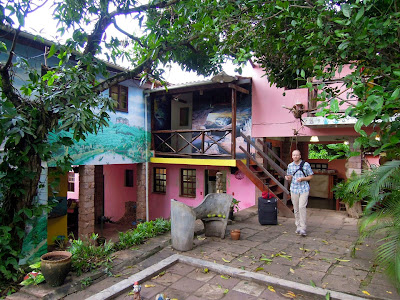On my last full day in Chapada Diamantina, we straight-up went to Oz, brick road and all. At least that’s what it felt like. The road that took us up the mountains wasn’t yellow, but it was cobbled, narrow, and had a storybook quality to it. Our car bumped up and down its stony path, as it climbed ever higher into drizzly, green mountain peaks. At the top was the small village of Igatu. Like Oz, Igatu felt exotic and mysterious, especially with the bright pockets of light glittering along the wet stone streets. And when the rain finally began to let up, the people of Igatu came out of hiding like Munchkins.
It was the rain that took us there in the first place. We had planned on spending the day in the wetlands, taking a boat through grassy swamps. But with the constant heavy downpour threatening to make the whole park into wetlands, we opted for less boating and more driving. Igatu is on the opposite end of Chapada Diamantina, to the south. The drive was relaxing. Dida’s playlist was a mixture of ambient electronica and sultry French singers. Even with the steady swiping of the wipers clouding the windshield, the outside landscape was captivating.
Along the way we stopped at Poço Encantado (Enchanted Well). This was one of those rare places, the likes of which I’ve seen on television or in travel magazines, but for me always felt like a fantasy-element; as if something so strange and alien couldn’t quite exist in our reality. Seeing it in person is awe-inspiring: a perfectly formed underground lake in a vast cavern, crystal-clear.
The water is so transparent that the first explorers of the cave hadn’t noticed it was there until some rocks slipped onto the surface and it rippled. 120 feet deep, rocks and ancient tree trunks are clearly visible at the bottom. Sunlight spills in from an opening high up the cavern wall and certain times of day it gives the water a deep blue hue. We sat in the cave a long time, staring at the water. It was dark, and I didn’t get my camera settings the way I wanted, so my photos don’t do it justice. Photos on Google Images get it better, but nothing I’ve seen quite captures it.
It was still raining by the time we reached the top of that crazy brick road and Igatu. The streets were empty. Once a town of thousands, the current population is less than 300. I was taken with the charm of Lençois, but Igatu took charm to a whole new level. Such a fantastic little village. We stopped briefly at Dida’s vacation home there, a studio-sized space seemingly carved into the walls of an alley, with a tiny front room, a kitchen, and a loft for sleeping. We would have spent the night there had we more time. Too bad!
We had lunch at an empty Pousada which was ridiculously bright and cozy. I wanted to spend a week there, just enjoying the place. Instead, we headed to the edge of town and hiked down to the ruins. The mountains of Chapada Diamantina used to be choked full of diamonds and diamond mining was big business before supply was depleted and the whole operation shifted to Africa. In its heyday, Igatu was heavily populated with a thriving community. Now, the old part of the city has fallen into ruins going back more than a century. It looked much older. The stone houses and walls are crumbling away, overgrown with vegetation. It all felt almost Paleolithic. I expected scruffy cavemen to come stumbling out, scratching their bellies.
A friend of Dida’s runs a gallery and museum in a little villa at the edge of the town cemetery. We stopped there to admire the antiques from the ruins in their glass display cases, browsed the art on display, then relaxed in the café with fruit ice cream. The rain had let up, but the smell of it was still thick. I could have sat there for a long time, but we had to go. The day was waning, and there was a long drive back to Lençois.
We spent the evening in darkness. The rain had somehow damaged the electrical grid, and Lençois lost power. No one was fazed. I guess it’s a regular occurrence. The main street was teeming with people, faces appearing in the dim candlelight the restaurants set on their outside tables. The mood was festive. A few restaurants down from ours, a tourist plucked at a guitar, and people sang. The lack of power limited our menu options, but the gas ovens still worked, and so, delicious pizza! Later I fell asleep with a book and a flashlight, waking abruptly at 2 a.m. when the fan in the room started noisily spinning. Power was back.
Dida drove us to the bus station early the next morning and we said our goodbyes. He had been a fantastic guide and if anyone reading this ever makes it to Chapada Diamantina, look the guy up! Despite everything I saw, there was still so many things I wish I could have seen. Leaving Lençois in many ways felt like leaving unfinished business. I need to get back there one day.





















































